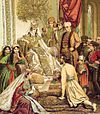| Sargis Zakarian Սարգիս Զաքարյան | |
|---|---|
 Tomb of Sargis and his father Vahram in Sanahin Monastery. The structure was built by his sons Ivane and Zakare. Tomb of Sargis and his father Vahram in Sanahin Monastery. The structure was built by his sons Ivane and Zakare. | |
| Amirspasalar | |
| In office 1181–1187 | |
| Preceded by | Kubasar |
| Succeeded by | Gamrekeli Toreli |
| Personal details | |
| Died | 1187 |
| Children | Zakare II Zakarian, Ivane I Zakarian, Nane (Inana), Dopi (Shushan), Tamta |
| Parent | Zakare I Zakarian |
Sargis Zakarian (Georgian: სარგის მხარგრძელი, romanized: sargis mkhargrdzeli; Armenian: Սարգիս Զաքարյան) was a founder of the Zakarid dynasty line. He was a Court official of the Kingdom of Georgia, holding the offices of Amirspasalar (Commander-in-Chief) for Queen Tamar of Georgia during the late 12th century. He was also ruler of feudal lands in the Kingdom of Georgia. He had two particularly famous sons: Ivane I Zakarian and Zakare II Zakarian.
Sargis rose to prominence at the Georgian court in 1177, when he supported George III of Georgia during a revolt of his feudal lords.
He was Commander-in-Chief of the Georgian army (Amirspasalar) from 1185, and he died in 1187 by the Georgian Queen Tamar. His son Zakare II Zakarian would inherit the title a few years later, from 1191.

Sargis appears in various inscriptions of the time, such as the dedicatory inscription for the repair of the Church of St. Amenaprkitch in Sanahin Monastery and the construction of a gavit adjoining it, by Abbot Yovhannēs in 1181:
In the year 630 (ie 1181 CE), at the time of the victorious king Georg, and amirspasalar Sargis and his sons Zak‘arē and Iwanē, and amira K‘urd, I, Yovannēs, Abbot of the holy monastery (re)built this once existing church and a gawit‘ from its foundations, with the help of amir K‘urd and the great vardapet Grigor and Christ God, with great hope...
Family
His wife was named Saakdukht Artsruni, of the House of Artsunids, their children were:
- Zakare II, Court official of the Kingdom of Georgia holding the office of Amirspasalar (Commander-in-Chief):
- Ivane I, Court official of the Kingdom of Georgia holding the offices of Msakhurtukhutsesi (Majordomo) and Atabeg (Governor General);
References
- Trails to the East: Essays in Memory of Paolo Cuneo. Environmental design. 2000. p. 72.
The mausoleum of the princes Vahram and Sarkis, respectively the grandfather and the father of the amirspasalars Zakaré and Ivané Zakarian; this structure was built in 1189, to the northwest of the monastery area of Sanahin.
- Allen, Tom; Holding, Deirdre (8 September 2023). Armenia: and Nagorno Karabagh. 289: Bradt Travel Guides. ISBN 978-1-78477-943-6.
{{cite book}}: CS1 maint: location (link) - ^ Lidov, Aleksej M. (1991). The mural paintings of Akhtala. pp. 14–16. doi:10.11588/diglit.27365.
After the decline of the Kjurikid state in the 12th century, the Zakharids went to serve the kings of Georgia in whose name they ruled part of the Armenian territories. In 1177 their position at the Georgian court was considerably strengthened when Sarkis Mkhargrdzeli went over to King George III's side during a revolt of his feudal lords. The family reached the height of its power, however, in the reign of Queen Tamar (1184-1213). She appointed Sarkis Mkhargrdzeli to the most important post of Amirspasalar or commander-in-chief of her armed forces. In 1191, a few years after his death, the title was inherited by his eldest son Zakare who had proved his loyalty to the Queen during a revolt by Yuri Bogoliubsky, her former husband
- Baumer, Christoph (5 October 2023). History of the Caucasus: Volume 2: In the Shadow of Great Powers. Bloomsbury Publishing. pp. 22–23. ISBN 978-0-7556-3630-3.
- Kiesling, John Brady (2001). Rediscovering Armenia: An Archaeological/touristic Gazetteer and Map Set for the Historical Monuments of Armenia. Tigran Mets. p. 48. ISBN 978-99930-52-28-9.
The gavit of S. Astvatsatsin was built by Prince Vache Vachutian (a more southerly dynast) in 1211, that of Amenaprkich in 1181 under the sponsorship of the Kyurikian family.
- ^ Vardanyan, Edda (1 January 2015). "The Žamatun of Hoṙomos and the Žamatun/Gawit' Structures in Armenien Architecture". Hoṙomos Monastery: Art and History, edited by Edda Vardanyan, Paris : ACHCByz: 216–217.
